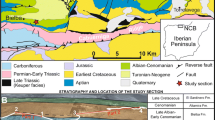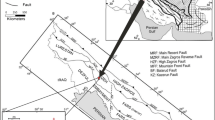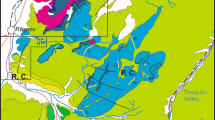Abstract
The foraminiferal limestones from the Middle Eocene Central Istrian region illustrate progressive deepening of depositional gradients. Shifting of Lower Cuisian to Upper Lutetian microfacies can be described in terms of a ramp model. The Orthophragminae-bearing parts of the foraminiferal limestones are interpreted in terms of larger foraminiferal faunal associations, planktonic foraminiferal relative abundance, limitations of algal endosymbionts, foraminiferal lamellar thickness and flattening of test shapes. Microfacies I contains the most diverse larger foraminiferal association with a predominance of large, thick nummulitids, assilinids, and asterocyclinids. Microfacies II is characterized by a gradual increase of Orthophragminae diversity and abundance. Nummulitids, equally abundant, are dominated by lenticular and subspherical specimens. The reduction in number of nummulitid specimens with characteristic biconical radiate morphologies, and relative abundance of flattened orthophragminids, characterizes Microfacies III. Scattered biodestructed orthophragminid tests and planktonic foraminifera constitute Microfacies IV, indicating the end of a long-lasting, shallow-marine Adriatic Carbonate Platform regime.







Similar content being viewed by others
References
Anonymous authors of Basic Geological Map of former Yugoslavia 1:500000, Federal Geological Institute (1970), Beograd
Accordi G, Carbone F, Pignatti J (1998) Depositional history of a Paleogene carbonate ramp (Western Cephalonia, Ionian Islands, Greece). Geol Romana n.s. 34:131–205
Aigner T (1983) Facies and origin of nummulitic buildups: an example from the Giza Pyramids Plateau (Middle Eocene, Egypt). Neues Jahrb Paläontol Abh 166:347–36
Barron EJ, Peterson WH (1991) The Cenozoic ocean circulation based on ocean General Circulation Model results. Palaeogeogr Palaeoclimatol Palaeoecol 83:1–28
Bassi D (1998) Coralline Algal Facies and their paleoenvironmentals in the Late Eocene of Northern Italy (Calcari di Nago, Trento). Facies 39:179–202
Bignot G (1972) Recherches stratigraphiques sur les calcaires du Cretace superieur et de l’Eocene d’Istrie et des regions voisines. Essai de revision du Liburnien. These Doct Etat, Trav Lab Micropaleont, 2. Univ Paris VI, Paris, 353 pp
Butterlin J, Vrielynck B, Guiraud R, Bignot G, Colchen M, Clermonte J, Andreieff P, Bellion Y, Benkhelil J, Cavelier C, Cornee JJ, Mercier de Lepinay B, Montenat C, Moreau C, Poisson A, Vila JM (1993) Lutetian palaeoenvironments (46 to 40 Ma). In: Dercourt J, Ricou LE, Vrielynck B (eds) Atlas Tethys palaeoenvironmental maps. BEICIP-FRANLAB, Rueil-Malmaison
Buxton M, Pedley H (1989) A standardized model for Tethyan Tertiary carbonate ramps. J Geol Soc 146/5:746–748
Ćosović V (1996) Discocyclinidal Foraminifera of Adriatic Carbonate Platform. Unpubl PhD Thesis, Univ Zagreb, 149 pp
Ćosović V, Drobne K (1995) Paleoecological significance of morphology of orthophragminids from the Istrian Peninsula (Croatia and Slovenia). Geobios 18:93–99
Ćosović V, Drobne K (1998) Lutetian Orthophragminae from the Istrian Peninsula (Adriatic Sea, Croatia and Slovenia). In: Drobne K, Hottinger L (eds) Paleogene shallow benthos of the Tethys. Dela—Opera SAZU 4 razr 34/2 Ljubljana, pp 173–181
Drobne K (1977) Alveolines Paleogenes de la Slovenie et de l’Istrie. Schweiz Paläontol Abh 99:1–132
Drobne K (1979) Paleogene and Eocene beds in Slovenia and Istria. 16th Europ Micropaleontol Colloq, pp 49–63
Drobne K (2000) The north-western part of the Adriatic Carbonate Platform from the K/T boundary to the Flysch Deposition during Paleocene—Eocene. Riassunti delle comunicazioni orali e dei poster. 80a Riunione Estiva, Trieste, 6–8 settembre 2000, pp 231–232
Drobne K, Ćosović V (1998) Repetitive order of appearance of larger Foraminifera and the ecological gradients preserved in Paleogene shallow benthic carbonate deposits. Tertiary to Recent larger Foraminifera. Their depositional environments and importance as petroleum reservoirs, conference and workshop: February 15–19th, 1998, Kingston Univ, 10 pp
Drobne K, Pavlovec R (1991) Paleocene and Eocene beds in Slovenia and Istria. Introduction to the Paleogene SW Slovenia and Istria. Field and guidebook IGCP Project 286 “Early Paleogene Benthos”, Second Meeting, pp 7–17
Drobne K, Pavlovec R, Ćosović V (1991) Section Ragancini-Lišani, Lower and Middle Lutetian. Introduction to the Paleogene SW Slovenia and Istria. Field and guidebook IGCP Project 286 “Early Paleogene Benthos”, Second Meeting, pp 83–85
Drobne K, Pavlovec R, Šikić L, Benić J (1979) Excursion F, Pićan, Istria—Cuisian, Lutetian. 16th Europ Micropaleontol Colloq, pp 177–184
Drooger WJ (1993) Radial Foraminifera, Morphometrics and Evolution. Verhandel Konink nederl Akad Wetten, Afd Natuurk E Reeks, Amsterdam, 241 pp
Ferrandez-Canadell C, Serra Kiel J (1992) Morphostructure and paleobiology of Discocyclina GÜMBEL, 1870. J Foramin Res 22/2:147–165
Flügel E (1982) Microfacies analysis of limestones, Springer, Berlin Heidelberg New York, 633 pp
Hallock P (1979) Trends in test shape with depth in large, symbiont-bearing Foraminifera. J Foramin Res 9:61–69
Hallock P (1985) Why are larger Foraminifera large? Paleobiology 11:195–208
Hallock P (1999) Symbiont-bearing Foraminifera. In: Sen Gupta BK (ed) Modern Foraminifera. Kluwer Academic Publishers, Dordrecht, pp 123–139
Hallock P, Glenn CE (1986) Larger Foraminifera: A tool for paleoenvironmental analysis of Cenozoic carbonate depositional facies. Palaios 1:55–64
Hamrla M (1959) O pogojih nastanka premogišč na Krasu. Geologija 5:180–264
Hamrla M (1987) Light reflectance of some Slovenian coals. Geologija 28/29:293–317
Hemleben C, Spindler M, Anderson OR (1989) Modern planktonic Foraminifera. Springer, Berlin Heidelberg New York, 363 pp
Hohenegger J (2000) Coenoclines of larger Foraminifera. Micropaleontol 46 (suppl 1):127–151
Hohenegger J, Yordanova E, Hatta A (2000) Remarks on West Pacific Nummulitidae (Foraminifera). J Foramin Res 30:3–28
Hohenegger J, Yordanova E (2001) Displacement of larger Foraminifera at the western slope of Motobu Peninsula (Okinawa, Japan). Palaios 16/1:53–72
Hollaus S, Hottinger L (1998) Temperature dependence of endosymbiontic relationships: evidence from the depth range of Mediterranean Amphistegina lessoni (Foraminiferida) truncated by the thermocline. Eclogae Geol Helv 90:591–597
Hottinger L (1977) Foraminifères operculinoformis. Mém Mus Nat Hist N Sér C Sc Terre 40. Muséum national d’Histoire naturelle Paris, 159 pp
Hottinger L (1983) Processes determining the distribution of larger Foraminifera in space and time. Utrecht Micropaleontol Bull 30:239–253
Hottinger L (1996) Sels nutritifs et bisedimentation. Mém Soc Géol France ns 169:99–107
Hottinger L (1997) Shallow benthic foraminiferal assemblages as signals for depth of their deposition and limitations. Bull Soc Geol Fr 168:491–505
Hottinger L (2000) Functional morphology of benthic foraminiferal shells, envelopes of cells beyond measure. Micropaleontol 46 (suppl 1):57–86
James NP, Collins LB, Bone Y, Hallock P (1999) Subtropical carbonates in a temperate realm: Modern sediments on the southwest Australia Shelf. J Sediment Res 69/6:1297–1321
Juračić M (1980) Depth of sedimentation of “Marls with Crabs” estimated from the ratio between planktonic and benthic Foraminifera. Geol Vjesnik 31 (1979):61–67
Langer M, Hottinger L (2000) Biogeography of selected “larger” foraminifera. Micropaleontol 46 (suppl 1):57–86
Less G (1987) Paleontology and stratigraphy of the European Orthophragminae. Geol Hungarica (Paleontologica) 51:373 pp
Luterbacher HP (1970) Environmental distribution of Early Tertiary microfossils, Tremp Basin, Northeastern Spain. ESSO Production Research—European Laboratories, 46 pp
Luterbacher HP (1984) Paleoecology of foraminifera in the Paleogene of the Southern Pyrenees. Benthos’83, 2nd Int Symp Benthos Foraminifera, pp 389–392
Marinčić S, Šparica M, Tunis G, Uchman A (1996) The Eocene flysch deposits of the Istrian Peninsula in Croatia and Slovenia: regional, stratigraphic, sedimentological and ichnological analyses. Annales 9/96:139–156
Marjanac T, Babac D, Benić J, Ćosović V, Drobne K, Marjanac Lj, Pavlovec R, Velimirović Z (1998) Eocene carbonate sediments and sea-level changes on the NE part of Adriatic Carbonate Platform (Island of Hvar and Pelješac Peninsula, Croatia). In: Hottinger L, Drobne K (eds) Paleogene shallow benthos of the Tethys. Dela—Opera SAZU 4 razr 34/2, pp 243–254
Matičec D, Vlahović I, Velić I, Tišljar J (1996) Eocene limestones overlying Lower Cretaceous deposits of western Istria (Croatia): Did some parts of present Istria form land during the Cretaceous? Geol Croatica 49/1:117–127
Moody R (1998) Part 3: Background Information on Metlaoui Carbonates. In: Moody R, Brown A, Loucks R (eds) Tertiary to Recent larger Foraminifera: their depositional environments and importance as petroleum reservoirs. Field Trip Guide. Arco—BG plc—Carthago Oil—Chevron Kingston, pp 2–23
Murray JW (1991) Ecology and distribution of planktonic foraminifera. In: Lee JJ, Anderson RO (eds) Biology of Foraminifera. Academic Press, London, pp 255–285
Odin GS, Matter A (1981) De glaucodiarum origine. Sedimentology 28:611–641
Nebelsick JH, Bassi D (2000) Diversity, growth forms and taphonomy: key factors controlling the fabric of coralline algae dominated shelf carbonates. In: Insalaco E, Skelton PW, Palmer TJ (eds) Carbonate platform system: components and interactions. Geol Soc Lond 178:89–107
Pavlovec R, Drobne K, Ćosović V, Šikić L, Benić J (1991) The Pićan Profile, Middle and Upper Cuisian, Lower and Middle Lutetian. Introduction to the Paleogene SW Slovenia and Istria. Field and guidebook IGCP Project 286 “Early Paleogene Benthos”, Second Meeting, pp 73–82
Pecheux MJF (1995) Ecomorphology of recent larger foraminifer Operculina ammonoides. Geobios 28/5:529–566
Piller WE (1994) The Northern Bay of Safaga (Red Sea, Egypt): an actuopaleontological approach IV. Thin section analysis. Beitr Palaontol Ősterr 18:1–73
Piller WE, Pervesler P (1989) The Northern Bay of Safaga (Red Sea, Egypt): an actuopaleontological approach I. Topography and bottom facies. Beitr Palaontol Ősterr 15:103–147
Premec Fuček V, Babić Lj, Bajraktarević Z, Gušić I (1998) Planktonic foraminiferal biostratigraphy and paleoecology of the Middle to Upper Eocene succession in the north Adriatic Sea. In: Hottinger L, Drobne K (eds) Paleogene shallow benthos of the Tethys. Dela—Opera SAZU 4 razr 34/2, pp 255–271
Racey A (1992) The relative taxonomic value of morphological characters of the genus Nummulites (Foraminiferida). Micropaleontol 11(2):197–209
Rasser MW (2000) Coralline red algal limestones of the Late Eocene Alpine Foreland Basin in Upper Austria: component analysis, facies and paleoecology. Facies 42:59–92
Reiss Z, Hottinger L (1984) The Gulf of Aqaba. Ecological micropaleontology, Ecological Studies 50, Springer, Berlin Heidelberg New York, 354 pp
Renema W, Troelstra SR (2001) Larger Foraminifera distribution on a mesotrophic carbonate shelf in SW Sulawesi (Indonesia). Palaeogeogr Palaeoclimatol Palaeoecol 175:125–146
Romero J, Caus E, Rosell J (2002) A model for the palaeoenvironmental distribution of larger foraminifera based on late Middle Eocene deposits on the margin of the South Pyrenean basin (NE Spain). Palaeogeogr Palaeoclimatol Palaeoecol 179:43–56
Salopek M (1954) Beiträge zur Kenntnis des geologischen Baues der Becken von Labin und Pićan in Istrien. Prir istraž Jugosl akad znan umjet 26:5–58
Serra-Kiel J, Hottinger L, Caus E, Drobne K, Ferrandez C, Jauhri AK, Less G, Pavlovec R, Pignatti J, Samso JM, Schaub H, Sirel E, Strougo A, Tambareau Y, Tosquella J, Zakrevskaya E (1998) Larger foraminiferal biostratigraphy of the Tethyan Paleocene and Eocene. Bull Soc Géol Fr 169/2:281–299
Sinclair HD, Sayer ZR, Tucker ME (1998) Carbonate sedimentation during early foreland basin subsidence: the Eocene succession of the French Alps. In: Wright VP, Burchette TP (eds) Carbonate Ramps. Geol Soc Lond pp 205–227
Stache G (1889) Die Liburnische Stufe und deren Grenz-Horizonte. Abh kk Geol Reichsanst 13, 170 pp
Spezzaferri S (1995) Planktonic foraminiferal paleoclimatic implications across the Oligocene-Miocene transition in the oceanic record (Atlantic, Indian and South Pacific). Paleogeogr Palaeoclimatol Palaeoecol 114/1:43–74
Šikić D (1965) Geology of the paleogene deposits in Istria and Dalmatia. Unpubl PhD Thesis, Univ Zagreb, 149 pp
Tari Kovačić V (1997) The development of the Eocene platform carbonates from wells in the Middle Adriatic Off-Shore Area, Croatia. Geol Croatica 50/1:33–48
Tucker ME (1993) Carbonate diagenesis and sequence stratigraphy. In: Wright VP (ed) Sedimentology review /1, Blackwell, Oxford, pp 51–72
Yordanova EK, Hohenegger J (2002) Taphonomy of larger Foraminifera: relationship between living individuals and empty tests on flat reef slopes (Sesoko Island, Japan). Facies 46:169–204
Acknowledgement
This study was financed by Project 0119402 of Croatian Ministry of Science and Technology. This paper benefited from suggestions given by Lukas Hottinger, Vlasta Tari, Anna Fugagnoli and Davide Bassi and their insights are greatly appreciated. We wish to thank Josip Benić and Vlasta Premec Fuček for identification of nannofossils and planktonic foraminifera. We are very grateful to J. Kuss and M. Rasser for their critical reading of this paper. It was substantially improved by their suggestions. Thanks also go to the Editor-in-Chief, A. Freiwald, for valuable advices. We are also indebted to R. Košćal for making computer drawings. Carrie E. Schweitzer is gratefully acknowledged for English correction of the final text.
Author information
Authors and Affiliations
Corresponding author
Rights and permissions
About this article
Cite this article
Ćosović, V., Drobne, K. & Moro, A. Paleoenvironmental model for Eocene foraminiferal limestones of the Adriatic carbonate platform (Istrian Peninsula). Facies 50, 61–75 (2004). https://doi.org/10.1007/s10347-004-0006-9
Received:
Accepted:
Published:
Issue Date:
DOI: https://doi.org/10.1007/s10347-004-0006-9




